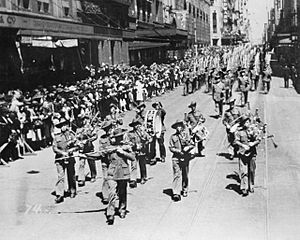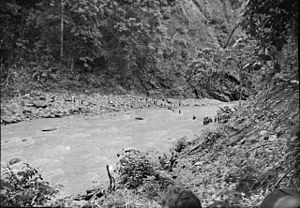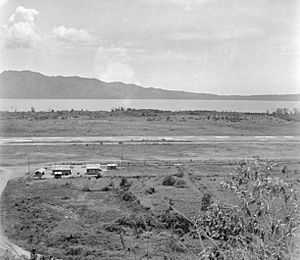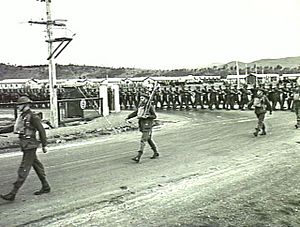8th Division (Australia) facts for kids
Quick facts for kids 8th Division |
|
|---|---|
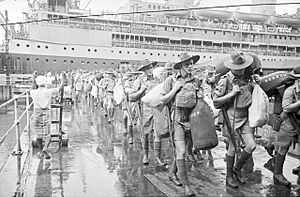
Soldiers from the 2/30th Battalion arriving in Singapore in August 1941.
|
|
| Active | 1940–1942 |
| Country | Commonwealth of Australia |
| Branch | Australian Army |
| Type | Infantry |
| Size | ~ 20,000 all ranks |
| Part of | Second Australian Imperial Force |
| Engagements | World War II |
| Disbanded | Ceased to exist in 1942 after majority of division were captured as prisoners of war. |
| Commanders | |
| Notable commanders |
Gordon Bennett |
| Insignia | |
| Unit colour patch |  |
The 8th Division was a group of soldiers in the Australian Army during World War II. It was made up of volunteers who wanted to fight overseas. The division was formed starting in July 1940.
It had about 20,000 soldiers and was split into different groups called brigades. These groups were sent to different parts of the Asia-Pacific region in 1941. This happened as war with Japan became more likely.
By February 1942, all parts of the 8th Division had been defeated. This happened during battles in Singapore, Rabaul, Ambon, and Timor. Most of the soldiers became prisoners of war (POWs). They were held until the war ended in 1945. Sadly, one out of every three prisoners died while in captivity.
Contents
History of the 8th Division
Forming the Division
The 8th Division started to form in July 1940. Its main office was in Sydney, Australia. Major General Vernon Sturdee was its first leader. This division was the third one created for the Second Australian Imperial Force. Many people volunteered to join after the Allies faced difficulties in Europe.
The division had about 20,000 soldiers. It included three main groups of foot soldiers called infantry brigades. It also had other supporting units. These included machine gun soldiers, anti-tank soldiers, and engineers. Each infantry brigade also had its own artillery (big guns).
The three infantry brigades were the 22nd, 23rd, and 24th. They were formed in different parts of Australia. In September 1940, the 24th Brigade was sent to North Africa. It joined the 9th Division there. The 27th Brigade took its place in the 8th Division.
The original plan was for the 8th Division to go to the Middle East. But as war with Japan seemed likely, plans changed. The 22nd Brigade was sent to Malaya in February 1941. They were there to help protect the area. This was meant to be a short stay.
Meanwhile, the 23rd Brigade moved to Darwin in April 1941. One of its battalions, the 2/22nd, was sent to Rabaul, New Britain. They were not ready for battle and were poorly equipped. The 27th Brigade joined the 22nd Brigade in Malaya in August. The rest of the 23rd Brigade was also split up. The 2/40th Battalion went to Timor, and the 2/21st Battalion went to Ambon. In October 1941, the 23rd Brigade was officially removed from the 8th Division's list. This was done to make command easier, as the division was so spread out.
Battles in Malaya
When war started in the Pacific, Japanese forces quickly moved through Thailand. They then invaded Malaya. Two British warships, HMS Repulse and HMS Prince of Wales, were sunk. This meant the Allies no longer controlled the seas. The Japanese could then land troops easily on the coast.
Japanese forces faced strong resistance from Indian and British units. But Japan had better air power, tanks, and fighting methods. This forced the British and Indian units to retreat. They moved back along the west coast towards Gemas and on the east coast towards Endau.
On January 14, 1942, parts of the 8th Division fought for the first time. This was south of Kuala Lumpur, at Gemas and Muar. The 2/30th Battalion had success at the Gemencheh River Bridge. They set up a large ambush and destroyed a Japanese battalion.
After this, the Japanese tried to go around the side towards Muar. The 2/29th and 2/19th Battalions were sent to help. They reinforced the 45th Indian Infantry Brigade. This brigade was in danger of being defeated near the Muar River. By January 22, a mixed group of Australian and Indian soldiers was cut off. They had to fight their way south to Yong Peng. Japanese soldiers later killed about 135 Allied prisoners at Parit Sulong. Lieutenant-Colonel Charles Groves Wright Anderson was awarded the Victoria Cross for leading his men out of danger.
On the east coast, the 22nd Brigade fought to slow down the Japanese. This was around Mersing. On January 26, the 2/18th Battalion ambushed the Japanese. This caused many Japanese casualties. It also gave the 22nd Brigade time to retreat south. The 27th Brigade fought to protect the rear. The 22nd Brigade was sent to guard the north end of the Johor–Singapore Causeway. This causeway linked Malaya to Singapore.
The Fall of Singapore
As Allied forces retreated to Singapore, more soldiers arrived. About 2,000 soldiers from the 8th Division came. This included the 2/4th Machine Gun Battalion. Many of these new soldiers had not finished their training. They were not ready for the tough fighting ahead.
By January 31, the last British Commonwealth forces left Malaya. Engineers blew up a 70-foot wide hole in the causeway. The Allied commander, Lieutenant-General Arthur Percival, gave the 8th Division a big job. They had to defend the main invasion points on the north side of Singapore Island. This area had many swamps and forests.
The 22nd Brigade had to defend a very wide area. It was 10 miles wide in the west. The 27th Brigade defended a 4,000-yard area in the north-west. The Japanese knew the Allied positions very well. They had good views from across the straits and used air patrols.
From February 3, Japanese artillery shelled the Australian positions. The shelling and air attacks grew stronger for five days. This destroyed communications between Allied units.
On February 8, at 8:30 pm, Japanese troops began landing. About 4,000 Japanese soldiers landed first. Australian machine gunners fired at their boats. Confused and fierce fighting happened all night. The Japanese had more soldiers. The Australian defenses were not well placed. Communications were poor. This allowed the Japanese to find gaps in the Australian lines. By midnight, the 22nd and 27th Brigades were separated. The 22nd began to retreat.
By 1:00 am, more Japanese troops landed, bringing the total to 13,000. The main Australian force was pushed back towards Tengah airfield. Small groups of soldiers fought to rejoin their units. Around dawn on February 9, another 10,000 Japanese troops landed. It was clear the 22nd Brigade was being overwhelmed. A new defense line was formed east of Tengah airfield.
The 27th Brigade had not yet been attacked. But the next day, the Japanese Imperial Guard tried a landing. It went wrong, and they lost many soldiers. Despite the 27th Brigade's success, they began to retreat. This was due to a misunderstanding between their leader and General Bennett. On the same day, communication problems led to the retreat of two Indian brigades. This caused the loss of a key ridge in the west of the island.
Australian battalions tried to fight back. But the British Commonwealth forces kept losing ground. The Japanese got within five miles of Singapore city. On February 10, they captured Bukit Timah. On February 11, the Japanese commander, Yamashita, asked Percival to surrender. He said it was "meaningless and desperate resistance."
The next day, the Allied lines tried to hold. An Australian reinforcement battalion was sent to counterattack. This attack was cancelled, but the battalion was not called back. It was later attacked by the Japanese 18th Division. The 27th Brigade tried to retake Bukit Timah. But the Japanese Imperial Guards defended strongly.
On February 13, General Bennett and other Australian officers told Percival to surrender. They wanted to save civilian lives. Percival refused. The next day, the remaining units fought on. Australians set up a defense line north-west of the city. They prepared for a final stand. Civilian casualties grew as people crowded into the Allied area. Bombing and artillery attacks got worse. There were fears the water supply would run out. Japanese troops killed 200 staff and patients at Alexandra Barracks Hospital.

By the morning of February 15, the Japanese had broken through the last defense line. Food and some ammunition were running out. After meeting his commanders, Percival contacted the Japanese. He formally surrendered the Allied forces to Yamashita. This happened shortly after 5:15 pm.
General Bennett caused a lot of debate. He handed over the 8th Division to another officer. Then he took a boat and escaped being captured. Many people criticized his leadership. He had given an order that Australian gunners should only support their own area. He did not tell Percival about this.
Almost 15,000 Australians became prisoners of war in Singapore. This was most of all Australian prisoners taken by the Japanese in World War II. Many died in the POW camps because of bad treatment. About 2,400 Australian prisoners died in the Sandakan Death Marches. A few managed to escape and kept fighting.
People have different opinions about the 8th Division's performance. Some reports blamed the Australians for losing Singapore. They said some Australian troops left the battle without leaders. Others, like Peter Thompson, said the 22nd Brigade was "so heavily outnumbered that defeat was inevitable." They argued that decisions by Bennett and Percival were more important.
Historian Christopher Coulthard-Clark said the 8th Division was one of the only British Commonwealth forces to have any success in Malaya. Thompson pointed out that the division did most of the fighting in Singapore. Even though they were only 14 percent of the soldiers there, they had 73 percent of the casualties. A British commander praised the Australian 2/29th for fighting with "great coolness."
Rabaul: A Difficult Battle
The 2/22nd Battalion, with 716 men, was the main fighting group in Lark Force. This was a 1,400-strong garrison in Rabaul, New Britain. They arrived there in March 1941. Rabaul was important because it was close to Japanese territory. The main job of Lark Force was to protect the airfield and flying boat base. These were used to watch Japanese movements. A small group of 130 men was sent to nearby New Ireland.
In January 1942, Japanese aircraft heavily attacked Lark Force. They destroyed the coastal artillery. In the early hours of January 23, 1942, 5,000 Japanese marines landed. Some faced strong resistance, but many landed easily. Fighting happened around Simpson Harbour. A company of troops from the 2/22nd fought to hold the Japanese. But the Japanese got past most of the resistance. After a short fight, Lakunai airfield was captured.
After this, the Lark Force commander, Lieutenant Colonel John Scanlan, ordered his soldiers and civilians to retreat. They split into small groups and went through the jungle. Only the Royal Australian Air Force (RAAF) had plans to leave. Their people were taken away by flying boats.
The Australian Army had not planned for guerrilla warfare. Most soldiers surrendered in the following weeks. At least 130 Australians, taken prisoner at the Tol Plantation, were killed on February 4, 1942. Some civilians and officers from mainland New Guinea organized unofficial rescue missions. Between March and May, about 450 troops and civilians were rescued by sea. At least 800 soldiers and civilian prisoners died on July 1, 1942. They were on a ship called the Montevideo Maru going to Japan. The ship was sunk by a US submarine.
A few Lark Force members stayed hidden on New Britain. They often worked with local people. They fought against the Japanese in small groups. Rabaul became the biggest Japanese base in New Guinea. Allied forces landed in December 1943. But many Japanese forces stayed on New Britain until Japan surrendered in August 1945. By the end of the war, over 600 members of the 2/22nd Battalion had died.
Ambon: A Tragic Battle
The island of Ambon, in the Dutch East Indies, was important. It could be a major air base for Japan. But by mid-December 1941, only a few RAAF bombers were there. There were also some older US Navy and Dutch Navy planes.
The 8th Division's Gull Force arrived on December 17. This group had 1,100 soldiers. It was led by Lieutenant Colonel Leonard Roach. It included the 2/21st Battalion and other support units. The existing Dutch army had 2,800 Indonesian soldiers with Dutch officers. Roach asked for more artillery and machine guns from Australia. He was replaced by Lieutenant Colonel John Scott on January 13, 1942.
Ambon was first attacked by Japanese aircraft on January 6. The Allied air defenses held out against the Japanese bombers. But on January 24, Japanese Zero planes appeared. The remaining Allied aircraft were pulled out. They were no match for the Zeroes.
On January 30, a Japanese fleet arrived. It had two aircraft carriers and about 5,000 Japanese marines and soldiers. The Japanese ground forces were not much larger than the Allies. But they had much more air support, naval guns, and tanks. Allied troops were mostly in the north of the island. They thought the south was too difficult for landings. However, the Japanese landed in the south. They also found less defended beaches. The Australians were supposed to defend the Bay of Ambon and the Laha and Liang airfields.
After the first landing, Allied troops had to move quickly. They tried to face the advancing Japanese. Large gaps formed in their defense lines. Within a day of the Japanese landing, the Dutch forces were surrounded. They were forced to surrender. The Australians of Gull Force retreated west. They held out until February 3, when Scott surrendered. A few small groups escaped to Australia. But most, almost 800 men, were taken prisoner.
According to Dr. Peter Stanley, a historian, several hundred Australians surrendered at Laha Airstrip. For two weeks after the surrender, over 300 prisoners taken at Laha were killed. The Australian government says the "Laha massacre was the largest of the atrocities committed against captured Allied troops in 1942."
Of the Australian prisoners on Ambon, three-quarters died before the war ended. They died from overwork, not enough food, and disease. They also suffered from very harsh treatment. Only 300 of those captured from Gull Force survived the war.
Timor: A Guerrilla Fight
In 1941, the island of Timor was split. Part was controlled by Portugal, and part by the Dutch. Australia and the Dutch agreed that Australia would send troops to West Timor if Japan entered World War II. So, a group of 1,400 soldiers, called the Sparrow Force, arrived at Kupang on December 12, 1941. This group was centered on the 2/40th Battalion.
The force was first led by Lieutenant Colonel William Leggatt. It also included Australian commandos. These were from the 2/2nd Independent Company. Sparrow Force joined about 650 Dutch and Portuguese soldiers. They were supported by 12 RAAF bombers and British anti-aircraft guns. The Allied forces were around the important airfield of Penfui. Portugal did not want to work with the Allies. So, the 2/2nd Independent Company and Dutch forces took over Portuguese Timor. They met no resistance. More Australian support staff arrived at Kupang on February 12. Brigadier William Veale became the senior Allied officer on Timor. By this time, many Australians were sick with malaria.
Timor was attacked by Japanese aircraft on January 26. The bombing got worse in February. An Allied convoy, carrying valuable reinforcements, had to return to Australia.
On the night of February 19/20, Japanese soldiers began landing in Portuguese Timor. The first contact was at Dili, the capital. The Allies were surprised. But they were ready. They caused many casualties to the Japanese attacking the airfield. The soldiers then destroyed the airfield. They began an organized retreat into the mountains. On the same night, Allied forces in West Timor were heavily attacked from the air. The RAAF force had already left for Australia. Sparrow Force HQ moved further east. It soon lost contact with the 2/40th.
The 2/40th's path to retreat was cut off. About 500 Japanese paratroopers landed. They set up a strong position. Sparrow Force HQ moved even further east. Leggatt's men attacked the paratroopers. By the morning of February 23, the Allies had killed almost all the Japanese in front of them. But the main Japanese force attacked them from behind. Leggatt's soldiers were low on ammunition. They were tired and had 132 wounded men. They had no contact with Sparrow Force HQ. Leggatt finally agreed to surrender. The 2/40th had 84 men killed in action. More than twice that number would die as prisoners of war.
Veale and the Sparrow Force HQ group continued east. They included some members of the 2/40th and about 200 Dutch soldiers. They joined the 2/2 Independent Company. The 2/40th effectively stopped existing as a unit. Its survivors joined the 2/2nd. They then fought in the guerrilla campaign on Timor. They were evacuated in December 1942.
After the Battles (1942–1945)
After escaping Malaya, General Bennett arrived in Melbourne in March 1942. The Australian Prime Minister, John Curtin, publicly said he was not at fault. However, the Australian high command gave Bennett a less important job. He was made commander of III Corps. This group was in charge of defending Western Australia. He was promoted to lieutenant general. But he never led troops in battle again. His escape actions were later investigated.
The 23rd Brigade's headquarters unit had not gone with its infantry battalions. It was used to form a new brigade. Three other battalions were assigned to it. These were the 7th, 8th, and 27th Battalions. This new 23rd Brigade later fought against the Japanese in 1944–1945. This was during the Bougainville campaign.
The 8th Division officially stopped existing in 1942. However, one of its artillery regiments, the 2/14th, kept serving until 1946. It was attached to other divisions.
During the fighting in Malaya, Singapore, Ambon, Timor, and Rabaul, the 8th Division lost over 10,000 men. This included 2,500 killed in action. This number was two-thirds of all deaths for the Australian Army in the Pacific. One of the division's battalions, the 2/19th, lost more men killed than any other Australian unit. Also, one out of every three captured soldiers died in captivity.
Leaders of the 8th Division
These officers led the 8th Division:
- Major General Vernon Sturdee (1940)
- Major General Gordon Bennett (1940–1942)
Units of the 8th Division
The following units were part of the 8th Division:
Infantry units (with the Australian state they came from)
- 22nd Brigade, New South Wales, (NSW)
- 2/18th Battalion
- 2/19th Battalion
- 2/20th Battalion
- 23rd Brigade
- 24th Brigade – moved to 9th Division in 1940
- 27th Brigade – joined from 9th Division in 1941
- 2/26th Battalion, Queensland (Qld)
- 2/29th Battalion, Vic.
- 2/30th Battalion, NSW
- Artillery regiments
- 2/9th Field Regiment, Royal Australian Artillery (RAA) – moved to 7th Division, 1940–1941
- 2/10th Field Regiment, RAA
- 2/11th Field Regiment, RAA – moved to 7th Division, 1940
- 2/14th Field Regiment, RAA
- 2/15th Field Regiment, RAA
- 2/3rd Anti-Tank Regiment, RAA – moved to 9th Division, 1940
- 2/4th Anti-Tank Regiment, RAA
- Other units
- 2/4th Machine-Gun Battalion, Western Australia (WA)
- 2/4th Pioneer Battalion
- 8th Divisional Cavalry – moved to 9th Division as 9th Divisional Cavalry, May 1941.
- Engineer companies
- 2/10th Field Company, Royal Australian Engineers (RAE), Vic.
- 2/11th Field Company, RAE, Qld
- 2/12th Field Company, RAE, NSW
- 2/6th Field Park Company, RAE
- 2/4th Field Park Company, RAE, WA – moved to 9th Division, 1940–1941
- Medical units
- 2/10th Australian General Hospital
- 2/13th Australian General Hospital
- 2/9th Australian Field Ambulance
- 2/10th Australian Field Ambulance (including transport)
- 2/4th Australian Casualty Clearing Station
- 2/2nd Australian Mobile Bacteriological Laboratory
See also


